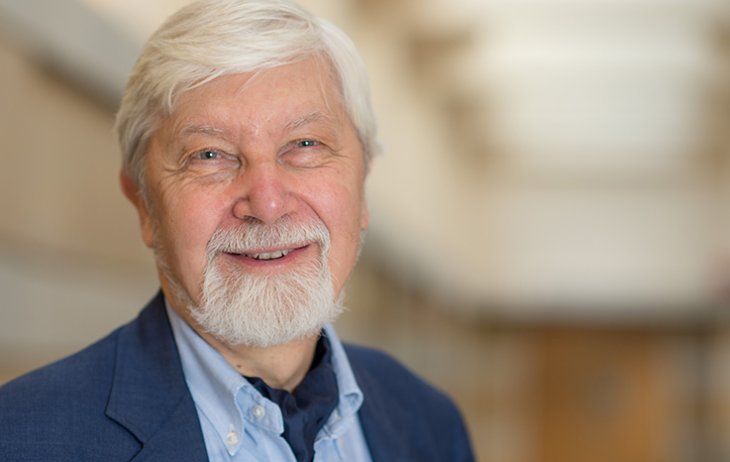
Peter Wallensteen in 2016. Photo: Barbara Johnston / University of Notre Dame
Peter Wallensteen, interviewed by Siri Aas Rustad
PRIO was the engine of our Nordic peace research network. To ‘go to PRIO’ meant to be updated on the state of the art, to find out what was going on. The ideas generated could then be taken back home and used to build up one’s own activities.
Siri Aas Rustad: You have been immensely important for the development of peace research. You have made your mark in Sweden, but also internationally as a pioneer in gender, peace and security studies and through the creation of the leading data collection project, the Uppsala Conflict Data Program. If you think back on your childhood, was there anything in particular that influenced you in the direction of international relations and peace research?
Peter Wallensteen: I was born in 1945. My family had always been interested in international questions, and we travelled a fair bit. For example, when I was 10, we went by boat and car to England. The large political event that made me interested in international politics was the Suez Crisis with invasion of Egypt by Israel, France and the United Kingdom in 1956, at the same time as the Soviet Union invaded Hungary.
This was a dramatic period, but there was one particular reason that I became concerned. As a young boy I was interested in football (soccer), and my foremost idol was a Hungarian player named Ferenc Puskás. He played on a team (Budapest Honvéd) that was in a way linked to the Hungarian army, which put him in a difficult situation. Then, suddenly, he disappeared. I tried to find out about Puskás’ whereabouts, but no one knew what had happened to him. I had to shift from the sport pages to the news pages to find out what was going on in Hungary.
So, in trying to know what had happened to Puskás, I became interested in international affairs. Incidentally, what happened to Puskás was that he refused to go back to Hungary after his team Budapest Honvéd lost in the European Cup in 1956. Later, Puskás played for Real Madrid for the rest of his career and did not go back to Hungary until 1991. The main football stadium in Budapest is now named after him.
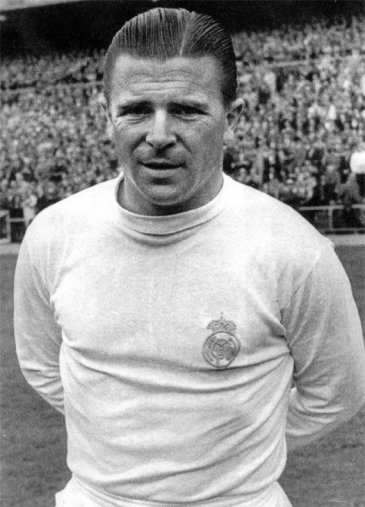
Ferenc Puskás. Photo: Wikimedia Commons
Another important and defining experience came in 1967. I was involved with a small peace research seminar at Uppsala University but was more engaged in the UN student club (Utrikespolitiska föreningen). The association had exchanges with students from Poland also bringing Swedish students to Poland. This was during the hard Communist rule in Poland, and we were going to the other side of the Iron Curtain, i.e. passing a very concrete border. I travelled there together with my fiancée, Lena Sahlin (since 1968: Lena Wallensteen).
During the stay, we visited a concentration camp outside Lublin: Majdanek. For me, this became an illustration of organized evil. Just to see the storehouses filled with shoes from may be more than 10,000 people. To see their eyeglasses and suitcases. The Holocaust suddenly became very real and I began to understand its sheer magnitude. Everything was terrifyingly large, and it was suddenly possible to comprehend the scale of the killings that had taken place. I was later told that more than 80,000 died in Majdanek. This made it clear that you cannot merely have an interest in international affairs: you have to deal with the problems in some way. After this traumatizing experience, I came to PRIO. There, I found a very different spirit.
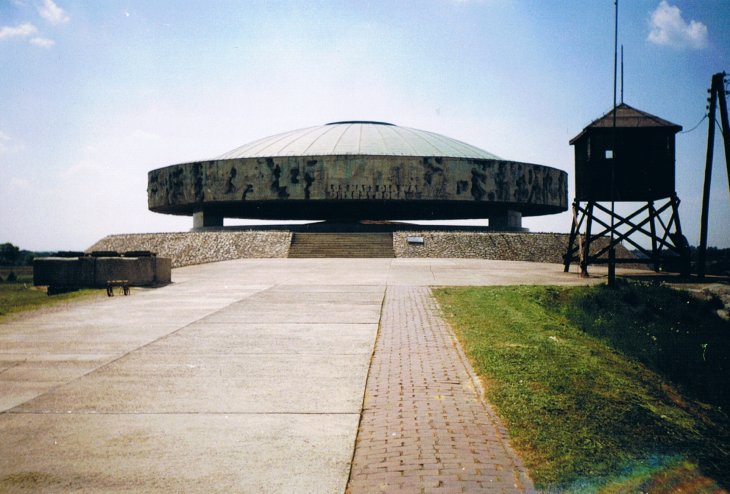
Monument in Majdanek, Poland, 2007. Photo: MesserWoland / Wikimedia Commons
The Holocaust suddenly became very real and I began to understand its sheer magnitude. […] This made it clear that you cannot merely have an interest in international affairs: you have to deal with the problems in some way
How was your first experience with PRIO?
My first encounter with PRIO was through meeting Johan Galtung in 1966 when I was a student at Uppsala University. I was working on my bachelor’s degree on sanctions and boycotts, inspired by the consumers’ boycott of oranges and wine from South Africa. When I met Galtung, he was working on the effect of sanctions in what was then Rhodesia, now Zimbabwe. I had already written several papers on Rhodesia and was connected to him in order to give him some knowledge of the country. It was during this collaboration that he said: ‘Why don’t you come to PRIO? We have a project on sanctions that you could work with’. He wrote me an invitation letter, and I got a stipend to come to PRIO in the spring of 1967, together with Lena. Ever since then, I have been in touch with PRIO.
At PRIO, we were a group of young people in our twenties, all of us engaged and determined to make a difference, and we were going to use reason, logic, intellect, data and research to achieve it. Galtung was in his element. He held lectures every week, sometimes even twice or more. He was inspiring, a good pedagogue – provocative but stimulating at the same time. If the rest of us failed to raise critical questions until the day after, it was too late, and he was already on to a new lecture on a new topic.
My time at PRIO became the opposite of the trauma I had experienced in Poland a few months earlier. It was then that I decided that peace research was important, which was the beginning of the long and difficult process towards the establishment of the Dag Hammarskjöld Chair in Peace and Conflict Research and the present department at Uppsala University.
How was life at PRIO in 1967?
When we came to PRIO, we met – in addition to Galtung – Ingrid Eide, who was a person that was easy to talk to. There was Mari Holmboe Ruge, Per Olav Reinton, Egil Fossum, Erik Ivås, Fredrik Hoffmann (who was also part of the project on sanctions), Helge Hveem and Sverre Lodgaard. And many talked about another person that impressed everyone: Nils Petter Gleditsch, but he was not there this semester. In addition, there were two Argentinians: Luis Stuhlman and Jorge Schnitman. There had been a military coup in Argentina and they were in Oslo as refugees. PRIO took care of them and integrated them quickly.
The days at PRIO were very structured. All seminars and meetings should happen between 08.30 and lunch. After lunch there should be no meetings, and everyone should have undisturbed work time. Every day started in Galtung’s office where he went through the mail, for example, invitations of various kinds. During lunch, we ate together in the Norwegian style with lunch boxes. We all sat in the kitchen around a big table with a red cloth. We soon discovered that Luis and Jorge did not have a lunch box, so Lena and I shared our lunch (lavishly provided by the Swedish-Norwegian center Voksenåsen) with them so that they could sit with the rest of us. The mealtime was an important social event.
We also attended other events together. Once, Johan asked us all to help out with preparing his boat, so we all did, and a few weeks later it was launched and then we had an excursion on the Oslo Fjord. We also attended debates at the Studentersamfunnet (The Student Society). Then, there was the Vietnam demonstration on the 1st of May. We walked past the US embassy. I remember that our Argentinian friends found it to be a rather boring protest. They were used to a much rougher atmosphere, and argued that if we had just had some stones then the US embassy would have been a perfect target with its glass facade. However, this was not the Norwegian way and the demonstration passed without any windows being broken.
When I had the opportunity to start our own graduate training programme twenty years later in Uppsala, my ambition was to create the same atmosphere as at PRIO: ‘We are in this together, and we are creating something together’.
I really enjoyed the atmosphere at PRIO, where everyone was informed about what the others were working on. Occasionally, Galtung would comment on our work – however, he was mindful of what he spent his time on. What is more, PRIO had a very collegial style, which I had not experienced at Uppsala. There, the Political Science department was hierarchical and negative. It was very competitive, and people were trying to break each other down all the time.
At PRIO, it was different. When I had the opportunity to start our own graduate training programme twenty years later in Uppsala, my ambition was to create the same atmosphere as at PRIO: ‘We are in this together, and we are creating something together. If you do well, I do well’. The research becomes much better in this type of environment.
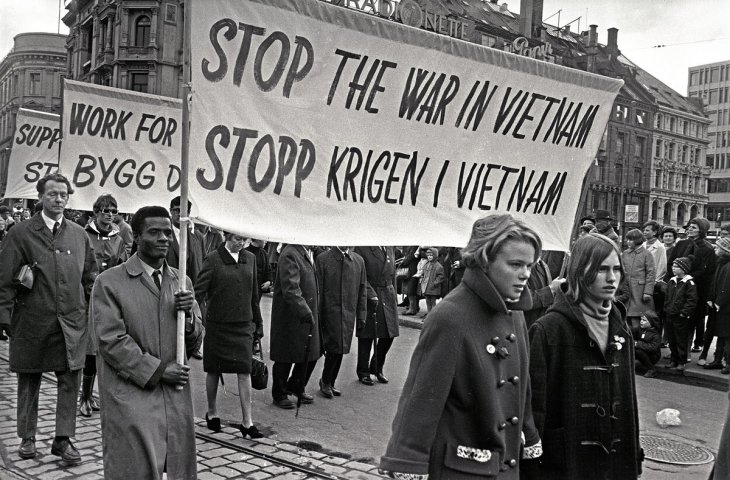
Vietnam demonstration, May 1, 1967, Oslo. Photo: Arbeiderbevegelsens arkiv og bibliotek / Digitaltmuseum / CC
How was the academic environment at PRIO during this period?
Johan started something he called ‘Theory Weeks’. In January 1967, he had a week like this on conflict theory, and again in 1968, and in 1969 it was development theory. This was really interesting because people from all the Nordic countries came. All young people. People like Håkan Wiberg, Raimo Väyrynen, Nils Petter Gleditsch and Anders Boserup. The day started with a lecture by Johan, a new topic every day. After that, there were presentations by everyone else. This helped create a good network between the Nordic countries.
We also organized Nordic conferences, further promoting the Nordic cooperation. PRIO was the engine of our Nordic peace research network. To ‘go to PRIO’ meant to be updated on the state of the art, to find out what was going on. The ideas generated could then be taken back home and used to build up one’s own activities.
For example, in Tammerfors/Tampere, Finland, the Tampere Peace Research Group was established in 1968. Further, peace research groups also developed in Lund, Copenhagen, and Gothenburg. And of course, in 1971 came the establishment of the Department of Peace and Conflict Research in Uppsala.
All these Nordic peace research networks developed their own distinctive character, but all were inspired by PRIO. Galtung and others were extremely supportive. If there were difficulties or arguments, Johan would use his prestige and position to support the newly established groups. This was really important, as they were mostly driven by young people without any experience of how the university worked.
After your stay at PRIO, did you go back to Uppsala to finish your master’s degree?
Yes, I went back and finished my licentiatexamen, which is what it was called in Sweden. This was a study of sanctions, which I had discussed with Johan Galtung and Fredrik Hoffmann at PRIO. I finished it in the fall of 1968, and a shorter version of it was published in Journal of Peace Research. This became my first academic article, called ‘Characteristics of Economic Sanctions’. Johan thought that was a fitting name. I published my master’s thesis on sanctions as a book a few years later.
After that, I started my PhD, and I wanted to look into not only what happens when trade ties are broken, but what happens when they are upheld. To look at trade as a tool of power. For instance, why is trade negative for some and positive for others? The PhD thesis was finished in 1973. Helge Hveem was the opponent. I continued my studies on sanctions, notably in the new forms of targeted, ‘smart’ sanctions, but the sanctions researchers remain few at PRIO as in Uppsala.
Can you talk a little about the establishment of the Department of Peace and Conflict Research in Uppsala, and your role in this?
In 1969 there was an opportunity to establish a course in Development Studies in Sweden. This was something that the Swedish government wanted to promote. However, for the university, this became a complicated matter. Should this be a matter of sociology or political science, or should it be something else? At the same time, colleagues and I were trying to get resources to further develop the small Peace Research Seminar. So, after some lobbying, the Minister of Education supported three programmes for peace research, in Uppsala, Lund and Gothenburg. This gave us the opportunity to make the small programme into a university unit.
The Dean of the Faculty (School) of Social Science was against this. However, there were others with an ambition to build up Soviet Studies in the same Faculty. So, we made an agreement that those who wanted the peace and conflict studies would vote for the Soviet studies and vice versa – together we became the majority at the faculty.
So, we made it happen, and the Department of Peace and Conflict Research was officially established in December 1971. In July 1972, I was hired as Assistant Professor (forskarassistent) in the newly established department, and I became head of this new unit (staying on until 1999). I presented my dissertation in Political Science the following year (1973) and became a docent (Associate Professor).
The three peace and conflict research programmes in Uppsala, Lund and Gothenburg developed differently. Uppsala and Gothenburg emphasized basic education with student courses, while at Lund they focused more on research and spent the resources differently. While Uppsala focused on peace and conflict research, Gothenburg focused on peace and development. The studies at Uppsala and Gothenburg became quite popular, and at the election for the national assembly (Riksdagen) in 1979, several political parties promised that they would strengthen peace research if getting into government.
Thus, in 1981 the Riksdagen decided to establish the Dag Hammarskjöld Chair in Peace and Conflict Research. With the launch of a professoriate followed a lot of resources, thus the Political Science department’s ambition was that this should belong to Political Science. However, I and several of those I work with wanted to create something new, something different than political science. International affairs are not central within Political Science, and we would become a periphery. For us to be able to have daily conversations about questions related to peace and conflict, like at PRIO, we needed to be our own institution.
I and several of those I work with wanted to create something new, something different than political science. For us to be able to have daily conversations about questions related to peace and conflict, like at PRIO, we needed to be our own institution
This became a pretty tough process. Also, here Galtung played an important role. The group that was going to decide on the professoriate consisted mainly of political scientists – peace research was hardly represented. In 1982, Johan wrote an article in Dagens Nyheter calling this an ‘academic scandal’. In Sweden, during this period, Galtung was seen as an important public intellectual and someone to be listened to. He was respected, particularly in the 1980s. He was not seen as provocative in Sweden, as he was in Norway. His claim about an academic scandal was often cited and repeated in the media, and it led to an interest from politicians and peace activists, as well as researchers at other universities. This had an enormous effect on the debate and I’m forever grateful that he chose to stick his neck out for us. For us, it was immensely encouraging to get this kind of support from someone who had been an inspiration since the 60s.
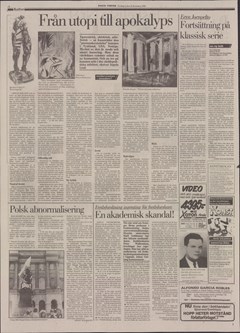
‘An Academic Scandal!’ in the newspaper Dagens Nyheter, December 1982.
This long process ended in January 1985 when I was appointed as the Dag Hammarskjöld Professor. I was personally very exposed in this affair and it was hard. Thus, for me, this was an extremely enlightening process in terms of how to manage crisis situations. Therefore, the inauguration ceremony in November 1985 became particularly important. Personally, I had never really liked ceremonies – I didn’t even go to my own ceremony after having defended my PhD. However, at this time, when I entered into the university auditorium, there was music, and everyone got up. I remember thinking: ‘why are they all standing? Because they are here to honour our research and academic achievement’. I looked around and I saw Galtung, Håkan Wiberg, Nils Petter Gleditsch, Raimo Väyrynen and all the others I had kept in touch with since the 1960s: probably around one hundred and fifty people who had followed the drama that this became. That felt pretty special. Since then, I have always encouraged my students to attend their graduation ceremonies. It gives a sense that to write a PhD thesis is very important, and that the university actually recognizes this in a solemn way.
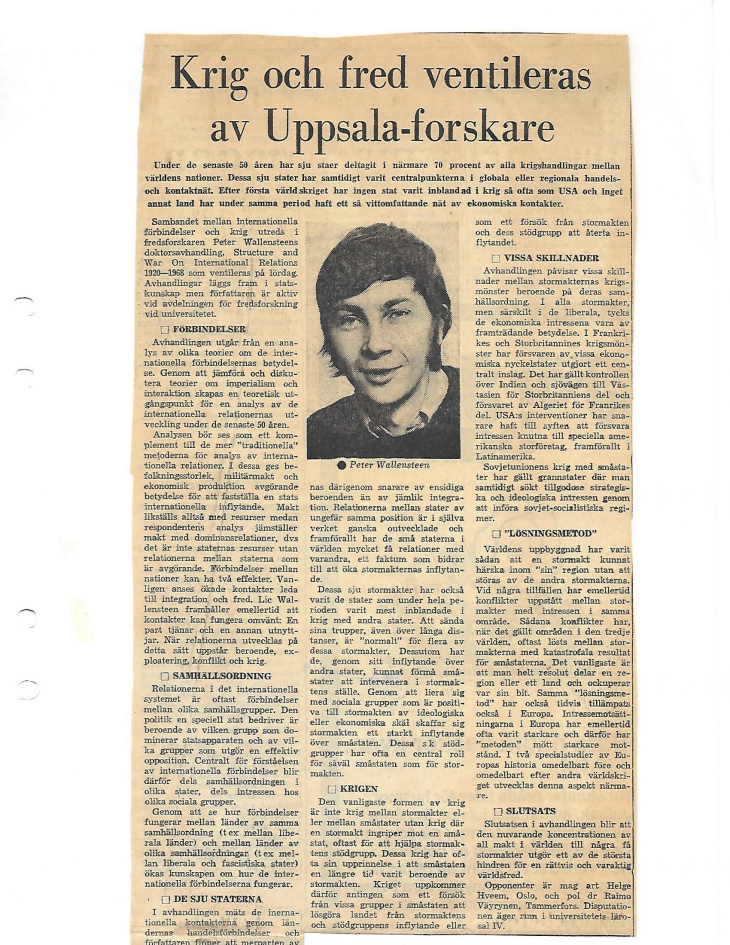
An article on Peter Wallensteen’s successful dissertation defense, published December 6, 1973, in the newspaper Upsala Nya Tidning. Illustration: Wallensteen’s private archives.
When the decision was made in 1985, it had taken fifteen years from when we started. We never thought it would take that long. The professoriate gave me an opportunity to start working towards a graduate programme. This was what I felt had been missing at PRIO.
PRIO had two problems. First, it was dependent on money from the Ministry of Foreign Affairs or similar external institutions. As part of the university, we had much more autonomy. Second, I felt that PRIO lacked a link to the university education. However, Galtung seemed very negative towards the universities, probably feeling that they were too traditional, conservative and difficult to change. I think it is really important to get this flow of students coming in, writing their master’s thesis, getting their PhD and finally becoming researchers. For peace research to be established within the university, the topic becomes less controversial and more accepted. The professoriate gave us the opportunity to educate people to become a doctor of peace and conflict studies. This is then their identity and will be part of their mission in life.
We had many eyes on us as we were building up our new institution. Was this really the right thing? I know that many at other institutions were sceptical that we were really going to succeed. So, it was really important that the first PhD theses turned out well. And they did. The first ones came in 1992, then more in 1993 and after that we had a nice flow. Now there are more than fifty people who have defended their PhDs – approximately the same number of men and women, which is great.
When we had established a group of senior researchers and lecturers, and when we had courses at all levels, I felt that my job was done. So, in 1999 I stepped down as the institute leader; by then, I had been in the role for twenty-seven years.
The most renowned part of the Department of Peace and Conflict Research at Uppsala is the Conflict Data Program (UCDP). Can you tell me a bit more about how that was established?
This started in 1978 as a small project, collecting daily information on conflicts that were reported on BBC World Service every midnight. A colleague, Ken Wilson, recorded this as we noticed that many of these violent incidents were never mentioned in print media. The idea was to get a more comprehensive picture of conflicts in the world.
It really took off when I was a visiting scholar at the University of Michigan in different periods between 1980 and 1984. This coincided with the difficult period during the establishment of the Dag Hammarskjöld professoriate, and this was probably my way of surviving and getting away from the drama. At Michigan I met David Singer, who pursued the big data project Correlates of War (COW). At that time, this was really high tech. Now it seems primitive in many ways, but this was groundbreaking, pioneering work.
[J. David] Singer was a great inspiration for me […]. During one period, I stayed at his home after he got divorced. I lived there for a couple of months and we discussed conflict definitions at breakfast, lunch and dinner
Singer was a great inspiration for me, in terms of both conflict data and the long discussions we had about definitions and conflict. During one period, I stayed at his home after he got divorced. I lived there for a couple of months and we discussed conflict definitions at breakfast, lunch and dinner. This was great fun. I criticized his data project for only including wars with more than one thousand dead – I thought that the threshold was too high. I argued that smaller conflicts are important in understanding escalation and de-escalation. But no, he thought that it was only the big ones that were important. Further, I criticized the COW data for not including what the conflict was about. He found that ridiculous. All wars were about power. Whatever else the warring parties claimed about the cause was irrelevant and simply things they said to gain support. However, I disagreed. I argued that if we are going to solve these conflicts, we need to know what they are about. Finally, he got irritated and said, but with a twinkle in his eye: ‘Well Peter, if you don’t like what I do, do your own thing!’ I thought that was a great answer.
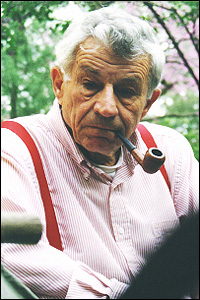
J. David Singer. Photo: Unknown
So, I thought: ‘Ok, I’ll do my own thing. We are going to do it here in Uppsala, and it is going to be very different from the COW data’. One element was to be able to publish it more widely. Thus, I made an agreement with SIPRI to have a chapter in its yearbook. The agreement continued until recently (i.e. for 30 years). Then there were all the discussions on how small conflicts could be accurately identified around the globe. In the end, we went down to an annual twenty-five battle-death threshold, beginning to publish this with the Journal of Peace Research. That involved a lot of discussions with, for instance, Nils Petter Gleditsch. Further, we wanted to include something about the incompatibility or dispute of the conflict. Studying conflicts in different countries, e.g. Thailand, it turned out to be possible to make a simple distinction between governmental and territorial conflicts. I think this worked really well and is very useful. I have noted that COW has since changed some of their definitions of civil wars, based on the UCDP.
The programme was not initially meant to be a big undertaking, but it has grown to be one of our most important and central projects. This is partly due to the collaboration with PRIO and, in particular, Nils Petter. In the beginning, UCDP delivered data to the SIPRI yearbook; however, the problem for us was that the data was seen as SIPRI’s and not ours. This was a reason for starting the collaboration with the Journal of Peace Research (JPR).[1] This has been a very positive collaboration, both for us and for JPR. The data became known as UCDP data, and it also lifted the JPR citations.
Singer taught me a lot about how to finance and organize a big project like this. He based his coding on work by master’s students, and this is how we started at Uppsala as well. However, we began to see data collection as a profession and realized that we needed people who really knew what they were doing and could do it the same way over the years and across the varying conflicts around the world.
Thus, the question about financing became critical. We wanted this to be a continuous project, but no research council or other funder was interested in funding it. We tried various sources, but finally I thought that this was a university concern. It was therefore great when it was written into the government’s proposition to Riksdagen that this was an important project. This meant that the university could allocate funding to it as it was a structurally important programme for both national and international research. Thus, UCDP has had regular support from Uppsala University for ten years. However, UCDP is continuously in development and is at the forefront of what is going on, which also means it gets external funding for new types of projects. I think that the geo-referenced coding is an incredible resource that is yet to be fully explored by researchers.
One of your ambitions with establishing a peace and conflict research programme was to show the importance and impact of this research. Do you feel that it has?
When the first PhDs were finished and turned out well it was important to establish that this research was useful. Therefore, I set up bi-annual executive seminars meant for policy-makers. We conducted six of these between 1991 and 2001.
In 1999, the seminar was on gender mainstreaming in peacekeeping operations. We organized a workshop in Uppsala about these issues, and it was really exciting as a set of pioneers on the subject came to Uppsala – amongst others, Louise Olsson, who was early in her career, and Ylva Blondel. Both really skilled researchers. Also, the chief of ‘Lessons Learned’ within the peacekeeping unit at the UN, Leonard Kapungu, and people representing the military attended. It was a very nice mix of researchers and practitioners.
The project was closing with a large conference in Windhoek, Namibia, so Ylva, Louise, I and several others went there to present our work. Kapungu was supposed to lead the meeting, but he suddenly got a call from Kofi Annan telling him go to Sierra Leone where the UN troops were in a crisis situation. So, he suddenly left the conference. The question was, then: what do we do now?
At the conference, there was a fascinating woman named Margaret Anstee – one of the few women who had led a peacekeeping mission (Angola, 1992–1993). She was appointed chair of the conference and she changed the agenda, arguing: ‘We cannot just go through research questions. This demands action: I think we should make an action plan’. I was concerned about my role; I was after all responsible for the money. Can we report an action plan rather than a research conference? But everyone else was so enthusiastic, so OK – let’s do it!
Ms. Anstee started asking questions like: What does research tell us about peace processes? Which women are included? What should we do about it? The conference participants started formulating points about what needed to be done. After a while, she said: ‘This has become very good. I will take this to my good friend the foreign minister of Namibia. And now we need to call this something’. We decided to call the document The Windhoek Declaration and the Namibia Action Plan for Gender Mainstreaming in Multidimensional Peacekeeping Operations. She brought this with her to a number of central people also in New York.
In October 2000, Namibia was president in the Security Council, and they could promote this action plan. It was then turned into a UN-resolution, Resolution 1325. If you look at it, it is really formulated as a set of researchable points. This was a fascinating project that started in Uppsala, and resulted in a UN resolution which I think is one of the better resolutions. This was one way of showing that the peace research that we were doing in the 1990s worked.
This has now grown into a fully-fledged research field both at PRIO and Uppsala with strong connections between the two institutions. For example, Louise Olsson is now a researcher at PRIO.
Thinking ahead, what do you think are the big questions that peace research should be concerned with?
There are a number of questions that we have not worked with as much as we should, for example human rights. There is surprisingly little research on this, we have left this for the lawyers. I’m not only thinking about individual human rights, but also women’s rights and the rights of minority groups. How do we secure these? How do you appeal violations? How can we make a change? These are really important questions right now, as we are in a period where democracy is about to erode from within.
Further, I think we need to continue the excellent research on gender conducted both at PRIO and at Uppsala. Gender issues are hugely important, and there is still much left to do. We need to further explore the results showing that gender equality actually has an effect in reducing the amount of conflict. We need both basic research and applied research.
The climate and conflict nexus is important. Much research is pointing towards the conclusion that there is no direct connection between the two phenomena. However, I think we need to think more about the preventive perspective. There are many difficult situations that are linked to inherent antagonisms within a society, such as between ethnic groups or between herders and farmers. The communities need to be more inclusive and we need better communication between the state leaders and minority groups.
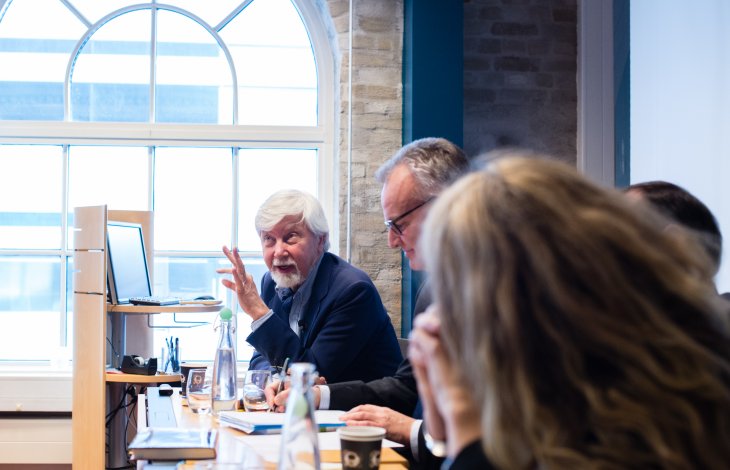
Peter Wallensteen participating in a panel discussion at a PRIO seminar. Photo: PRIO
The forth issue I’m missing is to study international institutions. What is it that makes so many perceive them as bureaucratic, difficult to administrate, and ineffective? I’m not so sure they are less effective than national institutions. We need some more innovative thinking about what global governance should look like. We need someone with Galtung’s visionary ability. I have tried to interest PhD candidates in these questions, but there is a greater interest in peace processes and questions like: how are things in Colombia? And what should we do with Hodeidah (a port in Yemen, where humanitarian aid was blocked by the warring parties in October 2018)? This is great, but we need to have a bigger picture of the planet and of global governance as well. I believe that, together, Uppsala and PRIO can come up with some valuable ideas about this!
We need some more innovative thinking about what global governance should look like. […] I believe that, together, Uppsala and PRIO can come up with some valuable ideas about this!
Finally, a small project that I’m part of now and which is a bit different is the connection between health, conflict and peace. The idea is to bring together the three United Nations Sustainable Development Goals (SDGs) on gender equality, health and peace. The aim is first to reduce violence, and second to build up transparent institutions. What is interesting about this project is that we are collaborating with people with a medical background. We have knowledge on how gender equality reduces violence, and they have knowledge on how gender equality improves health. How does the relationship between health and institutions look? It is really exciting to look for new connections. In peace research, we should not only talk about SDG 16 [to promote peaceful and inclusive societies for sustainable development, provide access to justice for all and build effective, accountable and inclusive institutions at all levels], we should also consider how we can connect that aim to the other SDGs.
Thank you very much, Peter.
—————————————————–
After the interview, we walk out of my office and bump into Stefan Döring, who is a PhD student at Uppsala and was Visiting Researcher at PRIO during the autumn of 2018. This chance encounter served to underline the strong relationship between PRIO and Uppsala, which originated with Peter Wallensteen.